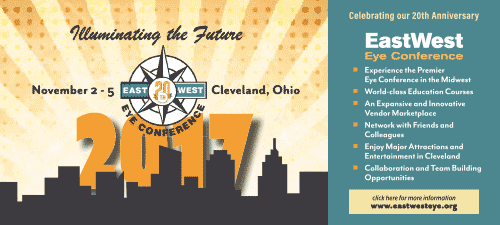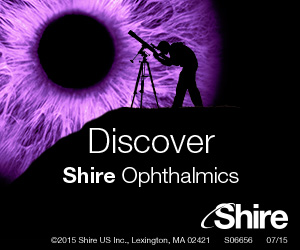
A
weekly e-journal by Art Epstein, OD, FAAO
Off the Cuff: 1-800 Contacts and the Future. What's the Opternative?
At some point we must accept the inevitably of unending, ever faster change. Today, technology touches everything we do. And while we've slowly, albeit sometimes grudgingly, accepted high-tech diagnostic tools, when it comes to consumer facing advances, we've largely stuck our heads in the sand. As a result, change has happened to us rather than we initiating and harnessing change. The growth of 1-800 Contacts is just one example. While our future demands we embrace technology and adapt to use it for our patients’ benefit, we must take a strong stand to ensure that technology is used in ways that keep patients safe. We must work together with ophthalmology leaders—both nationally and locally—to ensure that nascent technology is nurtured, and most importantly, that it is used to enhance care rather than bolster corporate profits at patients' expense.
|
|||||
 |
||
| Globe Rupture of a Post-LASIK Keratectasia Eye From Blunt Trauma | ||||
A 42-year-old man with a history of post-LASIK ectasia sustained paracentral corneal rupture secondary to blunt trauma from a fist to his left eye (OS). Slit-lamp examination revealed rupture in the posterior stroma (inferior paracentral) of the OS with an overlying intact LASIK flap; however, the inferior edges of the LASIK flap were Seidel positive. The anterior chamber was flat. Although he was initially managed with cyanoacrylate glue and a bandage contact lens, the patient eventually required tectonic penetrating keratoplasty. The postoperative course was unremarkable, and more than one year later, the visual acuity OS was 20/25 with -7.50 +2.00 × 0.50. Researchers wrote that globe rupture from blunt trauma has not been shown to be more common in patients with a history of LASIK. They added that, although blunt trauma to the post-LASIK globe would generally incur a similar risk of rupture to that of the normal eye, keratectasia after LASIK may predispose the globe to rupture. |
||||
| SOURCE: Cheung AY, Heidemann DG. Globe Rupture of a Post-LASIK Keratectasia Eye From Blunt Trauma. Cornea. 2016; Jul 27. [Epub ahead of print]. | ||||
 |
||
| Life Experiences of Patients with Glaucoma: A Phenomenological Study | ||||
Studies that describe the experiences of patients with glaucoma from different cultures may help health professionals gain a broader perspective on this issue. The aim of this study was to explore the experiences of patients with glaucoma. This descriptive phenomenological study used purposive sampling to enroll 20 patients with glaucoma. A qualitative, in-depth, face-to-face interview technique was used to collect data during January and February 2014. The data were analyzed using to the Van Kaam method. Seven themes were identified, including confirming the diagnosis by acute symptoms or unrelated symptoms, grateful to God for having a non-life-threatening disease, feeling happy after receiving more accurate information, coping with the disease by using eye drops and attending follow-up examinations regularly, managing daily life to avoid further damage to eyesight, emotional reactions related to going blind, and urging family members or friends to attend regular glaucoma checkups. Patients with glaucoma experience physiological and psychological problems throughout the course of their disease. Being informed, and cultural practices such as "praising God" and "resignation," helped patients cope with the disease. Furthermore, because of the cultural characteristic of social collectivism, participants acted to protect the health of others by informing them about glaucoma. |
||||
SOURCE: Iyigun E, Tastan S, Ayhan H, et al. Life Experiences of Patients With Glaucoma: A Phenomenological Study. J Nurs Res. 2016; Aug 2. [Epub ahead of print]. |
||||
 |
||
| Myopic Choroidal Neovascularization: Diagnosis and Treatment | ||||
This study reviewed and summarized the latest developments in the diagnosis and management of myopic choroidal neovascularization (mCNV). A review of the literature was performed, focusing on tests and investigations for diagnosing mCNV, as well as the key treatment options available for mCNV. Standard essential tests and investigations for diagnosing mCNV include spectral-domain optical coherence tomography for screening, fluorescein angiography for confirmation, and indocyanine green angiography and fundus autofluorescence for providing supplementary information. The current first line treatment of mCNV is the use of anti-vascular endothelial growth factor therapy. Various investigations can assist the differentiation of mCNV from other coexisting retinal pathologies associated with myopia or choroidal neovascularization resulting from other causes. Researchers concluded that prompt use of anti-vascular endothelial growth factor therapy had good efficacy and safety in the treatment of mCNV. |
||||
SOURCE: Lai TY, Cheung CM. Myopic Choroidal Neovascularization: Diagnosis and Treatment. Retina. 2016; Jul 29. [Epub ahead of print]. |
||||

|
||
| News & Notes | ||||||||
Study: Oral Omega-3 Supplementation Effective Treatment for Dry Eyes
|
||||||||
| Alcon Achieves FDA Approval for CyPass Micro-Stent Alcon received FDA approval for the CyPass Micro-Stent, a minimally invasive glaucoma surgical device to treat individuals with mild-to-moderate primary open-angle glaucoma in conjunction with cataract surgery. The approval is based on the COMPASS Study, with a two-year follow-up of more than 500 mild-to-moderate glaucoma cases undergoing cataract surgery. The primary effectiveness endpoint was met, with 73 percent in the Micro-Stent group achieving a statistically significant decrease (>= 20 percent) in intraocular pressure. The secondary effectiveness endpoint was also met, with 61 percent of individuals in the Micro-Stent group achieving a target IOP (between 6mm Hg and 18mm Hg) at the 24-month postoperative exam without medication—a statistically significant difference. Acquired in February by Alcon, Transcend Medical developed the CyPass Micro-Stent, which is implanted just below the surface of the eye in conjunction with cataract surgery to treat less severe glaucoma by enhancing part of the natural drainage pathways of the eye, with minimal tissue disruption. This enables excess eye fluid to drain in order to reduce intraocular pressure levels. Read more. |
||||||||
| ARVO Publishes 25th Anniversary Edition Commemorating OCT Invention The Association for Research in Vision and Ophthalmology published a special anniversary edition in its journal Investigative Ophthalmology & Visual Science with more than 70 articles to commemorate the 25th anniversary of the invention of optical coherence tomography technology, co-invented by Oregon Health & Science University Casey Eye Institute's David Huang, MD, PhD, while Huang was a doctoral student with James Fujimoto, PhD, at the Massachusetts Institute of Technology. OCT technology has evolved over the past 25 years with advances in imaging speed and quality. Eye care practitioners can now study disease at the microscopic level without biopsy, and with complete patient comfort. For the first time, eye physicians can visualize and measure blood flow in the smallest blood vessels, without the need to inject contrast agents. Dr. Huang was recently ranked the fourth most influential figure in the world of ophthalmology by The Ophthalmologist PowerList 2016. Read more. |
||||||||
| Novabay Completes $11.8M Private Placement NovaBay Pharmaceuticals closed a $4 million tranche of a private placement of common stock and warrants to accredited investors, bringing total proceeds to $11.791 million. The first tranche with proceeds of $7.791 million was completed in May 2016. The company is dedicated to increasing sales of Avenova and managing expenses to meet its goal of positive cashflow from operations by the end of 2016, said NovaBay’s chairman, president and CEO, Mark M. Sieczkarek, in a press release. Read more.
|
||||||||
|
Optometric Physician™ (OP) newsletter is owned and published by Dr. Arthur Epstein. It is distributed by the Review Group, a Division of Jobson Medical Information LLC (JMI), 11 Campus Boulevard, Newtown Square, PA 19073. HOW TO ADVERTISE |




